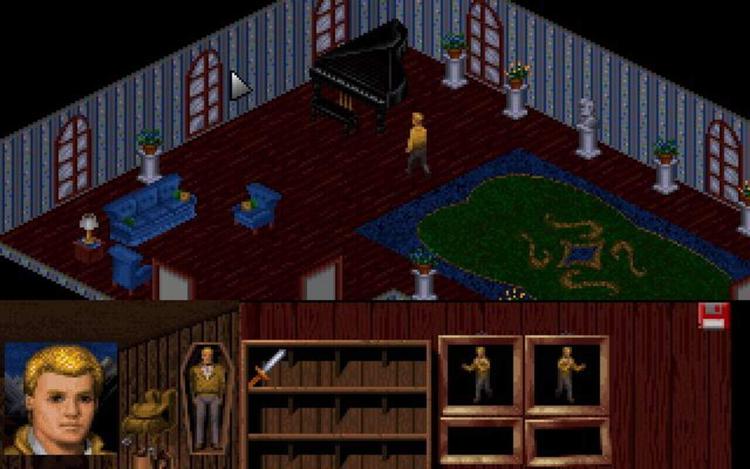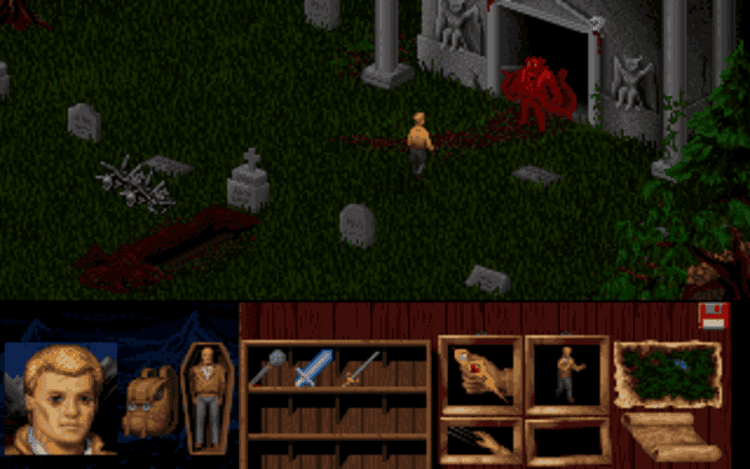
Veil of Darkness is a story-driven horror adventure game published by Strategic Simulations, where a downed pilot finds himself trapped in a cursed valley ruled by an ancient evil. Players explore shadowed streets, crypts, and manors, solving puzzles and battling night creatures through point-and-click interaction and real-time encounters. The mood evokes the dread of Alone in the Dark and the investigative tone of Gabriel Knight, while carving its own identity with folklore-rich dialogue and reactive choices. Whether you prefer to play online or revisit the game on classic setups, its atmosphere, exploration, and puzzle design remain gripping and timeless.
Veil of Darkness is a gothic horror adventure game published by Strategic Simulations, created by the team known for weaving rich narratives under the Event Horizon/DreamForge banner. From the moment a cargo plane crashes into a fog-bound valley, the story tightens its grip. The hero awakens in a remote village where daylight is anemic, superstition rules, and a vampire master’s dominion keeps the borders sealed. This premise delivers a potent blend of mystery and menace: every villager has a secret, every locked door hints at a sin, and every cemetery seems to whisper a name you haven’t learned yet.
What sets this game apart is its fusion of point-and-click adventure logic with measured action. Conversations carry weight, puzzle chains crisscross the valley, and a bestiary of folkloric horrors stands between you and freedom. It’s a game that trusts players to read, think, and observe, rewarding curiosity with lore fragments, new leads, and clever ways to overcome the night.
Veil of Darkness excels at tone. The environments are drenched in perpetual dusk, and the score underscores dread without overwhelming the moment-to-moment quiet. Houses feel lived-in rather than staged; every room might hide a crucial clue behind an innocuous prop. The writing leans on regional superstition and old-world legends, but avoids parody, grounding the drama in a community terrified into complicity.
The narrative progresses through intentional exploration. You talk to townsfolk, note what they avoid saying, and press on until evasions unravel into confessions. Tasks aren’t random errands; they grow from personal histories—a grieving parent, a reluctant ally, a scholar who knows more than is safe to say. Rituals, heirlooms, and forbidden manuscripts all play into a layered storyline that escalates from uneasy errands to confrontations with the valley’s ruling darkness. The pacing is confident: small victories reveal larger horrors, culminating in a battle that is as moral as it is physical.
The interface is accessible yet nuanced. Inventory puzzles hinge on context and timing, but solutions are fair if you track the world’s logic. Items aren’t merely keys; they express culture, faith, or fear. You’ll decipher symbols, brew remedies, and wield artifacts in rituals that make intuitive sense in this setting. Combat arrives sparingly but decisively, letting tension spike without derailing the investigative core. The isometric viewpoint supports both precise navigation and quick reactions when creatures emerge from the gloom.
Crucially, the game rewards note-taking and keen observation. Dialogues evolve as you progress; a villager who seemed closed off earlier might reveal a vital hint once you’ve changed the local balance of power. This dynamic keeps backtracking purposeful and makes the small map feel dense rather than thin. The result is a mystery where knowledge is your sharpest weapon, and where every solved riddle tightens the narrative screws.
Many horror adventures rely on jump scares, but Veil of Darkness builds dread through consequence. The valley remembers what you do. You feel the pressure of an oppressive ruler you rarely see, while the ordinary people under his rule embody the cost of survival. That human scale—fear in the bakery, guilt in the rectory, whispers behind shuttered windows—anchors the supernatural elements and makes the final confrontation feel earned.
Its visual style remains striking: restrained palettes, thoughtful lighting, and detail that supports storytelling rather than spectacle. The audio design complements the visuals with subtle stingers and ambient unease. Even today, the interplay of text, sound, and imagery creates a stage where your imagination fills the dark corners, which is exactly where the game wants you looking.
If you want to experience this classic without fuss, you can play Veil of Darkness online in a modern browser. The game can be enjoyed free, runs smoothly without restrictions, and plays well on mobile devices, letting you explore the cursed valley wherever you are. This approachable way to play makes revisiting its puzzles and narrative threads easy, preserving the original mood while removing barriers to entry.
Approach conversations as carefully as puzzles. The right name or topic can unlock entirely new paths, so make a habit of revisiting people after major discoveries. Examine rooms thoroughly; ordinary containers and everyday tools often carry unusual significance. When you encounter creatures, treat combat as problem-solving with stakes rather than an action loop; preparation and the correct item can be more decisive than reflexes.
Players who enjoyed the investigative cadence of Gabriel Knight or the foreboding exploration of Alone in the Dark will feel at home, yet Veil of Darkness maintains its own identity through Eastern European folklore and moral texture. It’s less about spectacle and more about pressure: a mystery that burdens you until you finally lift the valley’s curse.
Veil of Darkness remains compelling because it understands that horror is a social ecosystem. The vampire is terrifying, but so are the compromises people make to live under him. The game’s puzzles, exploration, and measured combat serve that idea cleanly, delivering a cohesive adventure that still rewards careful play and narrative curiosity. Typical controls involve mouse-driven movement and interaction for exploring, examining, and using items; combat and inventory actions are accessible through context-sensitive clicks and straightforward interface icons, making the experience intuitive even on a first playthrough.
All used codes are publicly available, and Veil of Darkness belongs to its original authors.
Share game
Share game








Share game